Bubble Tea Market Research, 2033
The global bubble tea market was valued at $3.1 billion in 2023, and is projected to reach $5.4 billion by 2033, growing at a CAGR of 5.9% from 2024 to 2033. Bubble tea, popularly known as boba tea, is a Taiwanese drink invented in Tainan and Taichung in the 1980s. It is prepared with tea or milk as the base component. This tea is glazed with boba, which are soft, chewy, and gummy tapioca pearls extracted from cassava root. Other ingredients, such as jelly and fruit balls, are used to enhance the texture of the tea. Bubble tea is served in a hot or cold form, according to the preference of consumers and a fat straw is used through which the pearls can be easily eaten by consumers. The adoption of bubble tea has been quite high in developed regions such as the U.S., Canada, and Germany while emerging countries such as China, Brazil, and India have caught up quickly.
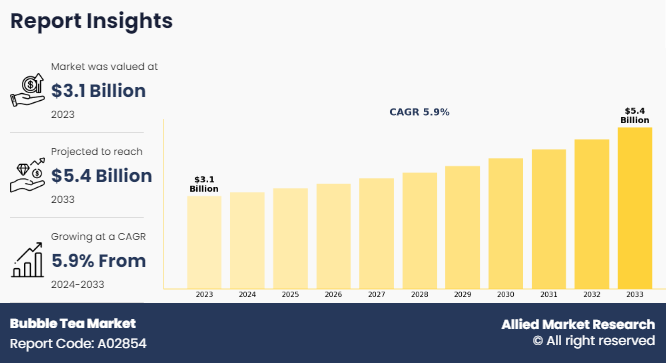
Market Dynamics
Changing consumer preferences has played a pivotal role in the remarkable growth of the bubble tea market. One of the key indicators of shifting preferences is the rising demand for diverse flavors and innovative concoctions. Traditional tea flavors have given way to exotic and adventurous choices such as taro, lychee, matcha, and various fruit infusions, expanding the market's appeal. Moreover, the customization aspect, where customers can choose their sugar levels, toppings, and even dairy alternatives, reflects a consumer-driven trend towards personalized, health-conscious choices.
The success of bubble tea also aligns with the Millennial and Gen Z generations, who prioritize experiences and shareable moments. The visual appeal of bubble tea with its colorful pearls and Instagram-worthy aesthetics has made it a staple in social media culture. Consequently, as consumer preferences continue to evolve, bubble tea's adaptability and innovation remain pivotal drivers of its market success.
Franchising and business expansion have played a pivotal role in the remarkable growth of the bubble tea market. This trend is exemplified by the rapid expansion of well-known bubble tea brands such as Chatime and Gong Cha, which have successfully adopted franchising models. For instance, Chatime, operates over 2,500 outlets across 38 countries, highlighting the global appeal of bubble tea. Gong Cha has expanded its footprint to more than 50 countries. These franchises provide a template for aspiring entrepreneurs, simplifying the process of entering the bubble tea market. Franchisors offer comprehensive support, including operational guidance, marketing strategies, and access to established supply chains, making it easier for new outlets to maintain quality and consistency. This expansion has not only fueled the market's growth but also diversified the industry's reach, making bubble tea a familiar and accessible option for consumers worldwide. As the franchise model continues to be embraced, it further cements the industry's position as a global beverage phenomenon.
However, health and safety regulations in the bubble tea market have become increasingly stringent, impacting its growth in several ways. Firstly, the heightened scrutiny of food safety standards, particularly in the post-COVID-19 era, has necessitated additional investments in sanitation and hygiene measures. Bubble tea shops have had to allocate resources for increased cleaning and sanitation practices, which can strain their operational budgets and reduce profitability. Moreover, stricter regulations have led to more rigorous inspections, often resulting in closures or fines for non-compliance, which can be financially burdensome for smaller businesses. Additionally, social distancing and capacity restrictions have affected foot traffic and the in-store dining experience, further hindering sales. Furthermore, the enforcement of contactless payment methods and online ordering to reduce physical contact has imposed additional technology and infrastructure costs. In summary, while health and safety regulations are essential, their stringent nature can impose financial burdens and operational challenges that may slow down market growth, particularly for small and medium-sized bubble tea businesses.
The global bubble tea market has witnessed significant growth over the years and is expected to grow at a steady pace during the forecast period. This is attributed to the growth in health awareness and the rise in adoption of bubble tea, owing to its health benefits and popularity among health-conscious consumers and the young generation. The availability of bubble tea at lower prices and the introduction of additional healthy ingredients in it by different market players drive the global bubble tea market growth.
In addition, the rise in the number of vegan people helps to drive the growth of the market. However, excess sugar content in these drinks leads to health issues, and the trend of coffee consumption is expected to restrict the market growth. In addition, consumers have changed their preference toward organic beverages, due to the presence of artificial preservatives in bubble tea, which hampers the growth of the global bubble tea market. On the contrary, the introduction of various new flavors and blends is expected to provide lucrative opportunities for market expansion.
Expanding into new markets presents a compelling opportunity for the bubble tea industry, which is driven by several key factors. Firstly, the global appeal of bubble tea is evident from its growing presence in various countries. For instance, in the U.S., the number of bubble tea shops increased by over 15% from 2016 to 2021, demonstrating a strong market presence. This trend is mirrored in regions such as Europe, where bubble tea has gained popularity among a diverse customer base. Additionally, Asian countries, where bubble tea originated, continue to be robust markets with a high degree of consumer acceptance and demand. As a testament to this, China, one of the largest bubble tea markets, has seen a surge in the number of outlets. Furthermore, the flexibility of bubble tea recipes allows for adaptation to local tastes, such as adding regional fruits and flavors, making it well-suited for international expansion. This adaptability, coupled with consumer curiosity and a preference for unique beverages, is driving the bubble tea industry favorably for a successful expansion into new and emerging markets.
Digital transformation presents a compelling opportunity for the bubble tea market. In an era where convenience and technology are integral to consumer experiences, leveraging digital tools can significantly enhance the industry. As evidenced by the rise of mobile apps and online ordering platforms, digital transformation streamlines the ordering and delivery processes, making it more convenient for customers to access their favorite bubble tea. Moreover, it enables businesses to collect and analyze customer data, which can be used to personalize marketing efforts and enhance customer loyalty programs. Many successful bubble tea chains have embraced mobile apps, allowing customers to place orders, earn rewards, and receive promotions, thus fostering customer engagement and increasing sales. This digital shift aligns with the expectations of today's tech-savvy consumers and offers the industry a competitive edge in an increasingly digital marketplace.
Segment Overview
The bubble tea market is segmented on the basis of flavor, base ingredient, component, end user, and region. On the basis of flavor, it is categorized into original flavor, coffee flavor, fruit flavor, chocolate flavor, milk flavor, and others. On the basis of base ingredient, it is divided into black tea, green tea, oolong tea, and white tea. On the basis of component, it is classified into flavor, creamer, sweetener, liquid, toppings, and others. On the basis of end user, it is segmented into generation Z, millennials, and generation X. On the basis of region, it is analyzed across North America, Europe, Asia-Pacific, and LAMEA.
By Flavor
According to the bubble tea market share, based on flavor, the fruit flavor segment was the most prominent segment accounting for the highest share in the bubble tea market, in 2023. This can be attributed to a change in the preference of consumers toward healthy beverages and better taste. However, the chocolate flavor segment is expected to witness the highest growth, owing to an increase in its popularity in all age groups for all flavored beverages and a rise in awareness of the health benefits of chocolate among consumers.
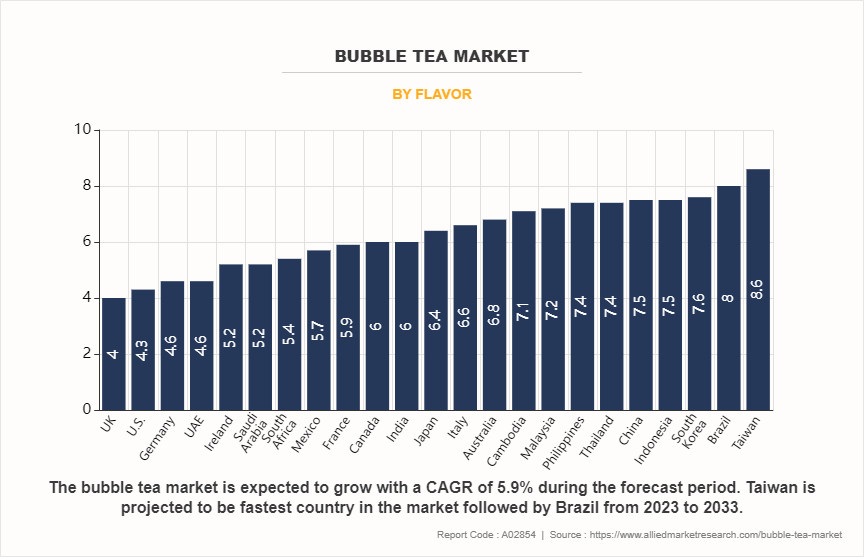
By Base Ingredient
According to the bubble tea market analysis, by base ingredient, the black tea segment generated maximum revenue in 2023 and is expected to continue this trend throughout the forecast period. This can be attributed to rise in the popularity of bubble tea with black tea as a base ingredient across the globe. However, the green tea segment is expected to witness the highest CAGR throughout the forecast period, owing to growth in the number of health-conscious consumers globally.
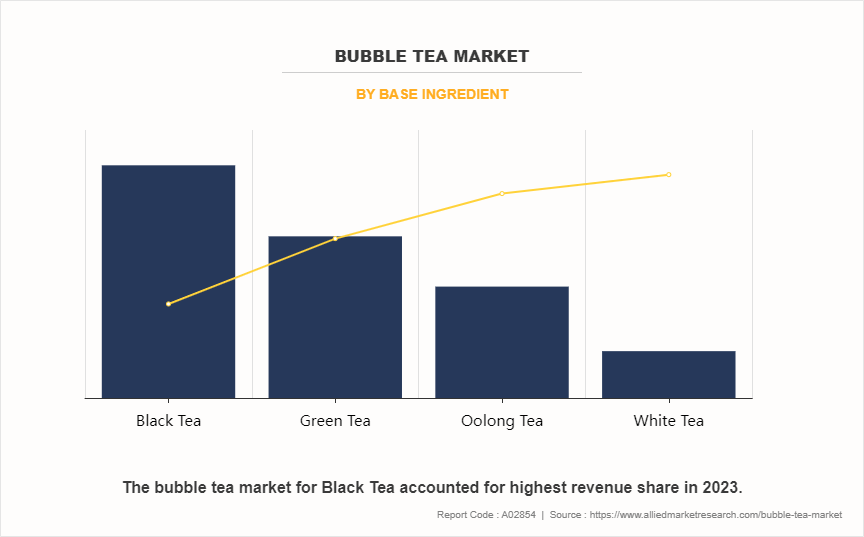
By Component
Based on the bubble tea market forecast, the liquid component was the most prominent segment accounting for the highest share in the bubble tea market. This can be attributed to the availability of various options such as a combination of various liquid flavors and syrups. However, the sweeteners segment is expected to witness the highest growth, owing to rise in demand for sweet beverages across the globe.
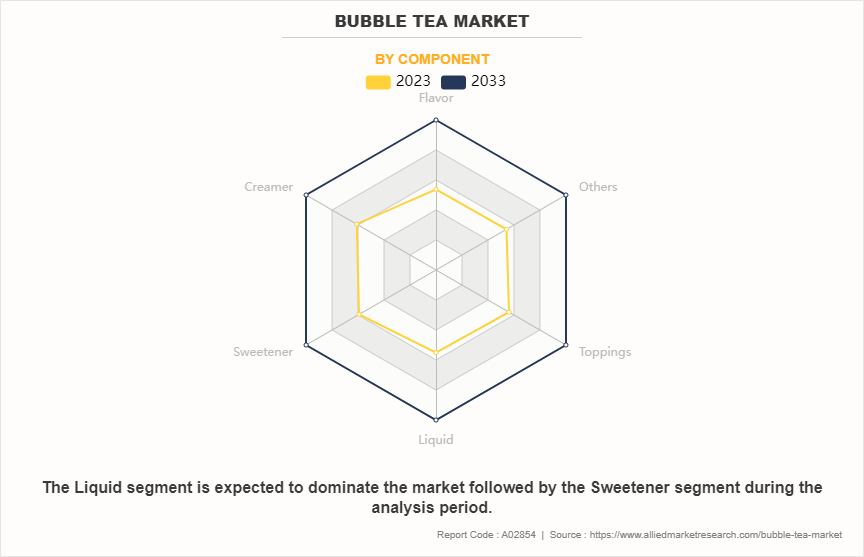
By End User
The millennials segment was the most prominent segment accounting for the highest share of the bubble tea market. Millennials' love of unique flavors, visually appealing designs, and customizable possibilities have led to a surge in the bubble tea market. Bubble tea's unique blend of innovation and tradition appeals greatly to this group, which values experiential eating and health-conscious options. Its appeal in this market is further enhanced by social media trends and influencer culture.
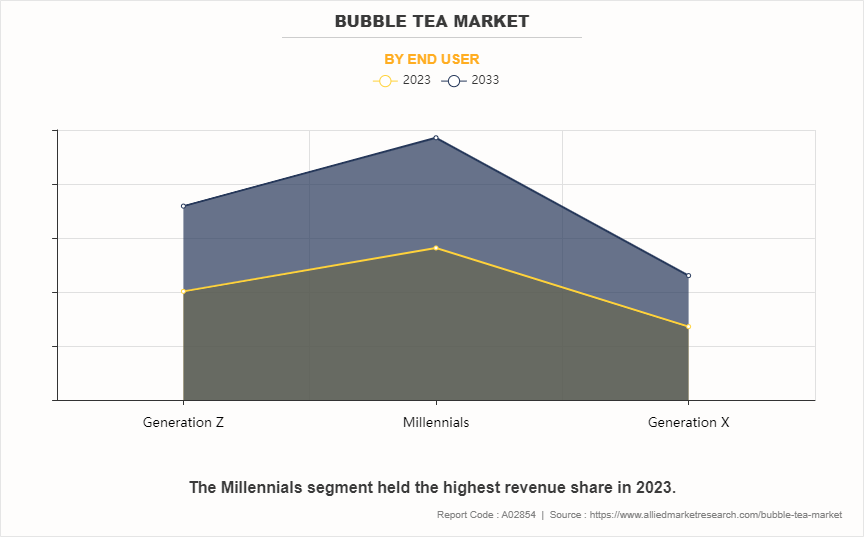
By Region
By region, North America was the most prominent regional market in 2023. This can be attributed to rise in awareness regarding healthy lifestyles and higher adoption of healthy beverages by health-conscious consumers. Moreover, the higher expenditure of consumers on healthy beverages adds to the popularity of bubble tea in the region. However, Europe is expected to grow with the highest CAGR throughout the forecast period, owing to aggressive advertising celebrity brand endorsement, and an increase in the awareness of bubble tea in the region.
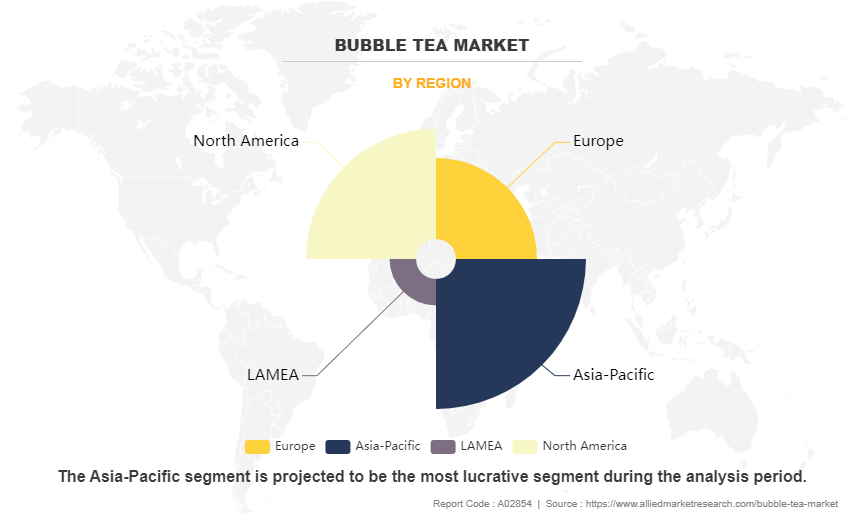
Competitve Analysis
The key players operating in the market include Lollicup USA, Inc., CuppoTee Company, Bubble Tea House Company, Ten Ren's Tea Time, Boba Box Limited, Sumos Sdn Bhd, Gong Cha USA, Boba Tea Company, Troika JC. (Qbubble), and Fokus Inc. The other players operating in the global bubble tea market are Bubble Tea Supply Inc., ChaTime, CoCo Fresh, Quickly, Kung Fu Tea, Boba Loca, Happylemon, Share Tea, T Bun International, Fanale Drinks, Grand Chainly, and Huey-Yuhe Enterprise.
Key Benefits for Stakeholders
- This report provides a quantitative analysis of the market segments, current trends, estimations, and dynamics of the bubble tea market analysis from 2023 to 2033 to identify the prevailing bubble tea market opportunities.
- The market research is offered along with information related to key drivers, restraints, and opportunities.
- Porter's five forces analysis highlights the potency of buyers and suppliers to enable stakeholders make profit-oriented business decisions and strengthen their supplier-buyer network.
- In-depth analysis of the bubble tea market segmentation assists to determine the prevailing market opportunities.
- Major countries in each region are mapped according to their revenue contribution to the global market.
- Market player positioning facilitates benchmarking and provides a clear understanding of the present position of the market players.
- The report includes the analysis of the regional as well as global bubble tea market trends, key players, market segments, application areas, and market growth strategies.
Bubble Tea Market Report Highlights
| Aspects | Details |
| Market Size By 2033 | USD 5.4 billion |
| Growth Rate | CAGR of 5.9% |
| Forecast period | 2023 - 2033 |
| Report Pages | 250 |
| By Flavor |
|
| By Base Ingredient |
|
| By Component |
|
| By End User |
|
| By Region |
|
| Key Market Players | Gong cha Global Ltd, Bubbleology, Bubble Tea House Company, Boba Box Limited, Sumo's (M) Sdn Bhd, TP Tea, KF Tea Franchising LLC, Chatime Global LLC, Tbaar Inc., Cuppo Tee Company Limited |
Analyst Review
The global bubble tea market holds a substantial scope for growth during the forecast period. Presently, the market has moved toward the growing stage and is expected to garner steady growth in major markets, which include the U.S., Germany, China, India, and Brazil.
CXOs from the leading companies perceive that product innovation, the development of newer flavors, and the use of organic preservatives & color in the manufacturing process are the major areas of growth for the bubble tea market. Moreover, an increase in disposable income and economic growth in advanced & emerging economies support the market growth. According to the CXOs, Europe is projected to register significant growth as compared to Asia-Pacific and North America due to rapid urbanization, a rise in consumption of healthy beverages, and the low price of bubble tea. Moreover, as per research conducted by different reputed organizations, tea is proven to prevent different types of cancers, lower cholesterol, help boost immunity, facilitate weight loss, and prevent neurological diseases. This indicates that the health benefits associated with bubble tea are anticipated to drive the overall market.
The global bubble tea market size was valued at USD 3.1 billion in 2023, and is projected to reach USD 5.4 billion by 2033
The global bubble tea market is projected to grow at a compound annual growth rate of 5.9% from 2024-2033 to reach USD 5.4 billion by 2033
The key players profiled in the reports includes Lollicup USA, Inc., CuppoTee Company, Bubble Tea House Company, Ten Ren's Tea Time, Boba Box Limited, Sumos Sdn Bhd, Gong Cha USA, Boba Tea Company, Troika JC. (Qbubble), and Fokus Inc. The other players operating in the global bubble tea market are Bubble Tea Supply Inc., ChaTime, CoCo Fresh, Quickly, Kung Fu Tea, Boba Loca, Happylemon, Share Tea, T Bun International, Fanale Drinks, Grand Chainly, and Huey-Yuhe Enterprise.
Asia-Pacific dominated in 2023 and is projected to maintain its leading position throughout the forecast period.
Changing Consumer Preferences, Appeal to Millennial and Gen Z Generations, Franchising and Business Expansion, Health Benefits and Popularity Among Health-Conscious Consumers majorly contribute toward the growth of the market.
Loading Table Of Content...
Loading Research Methodology...



